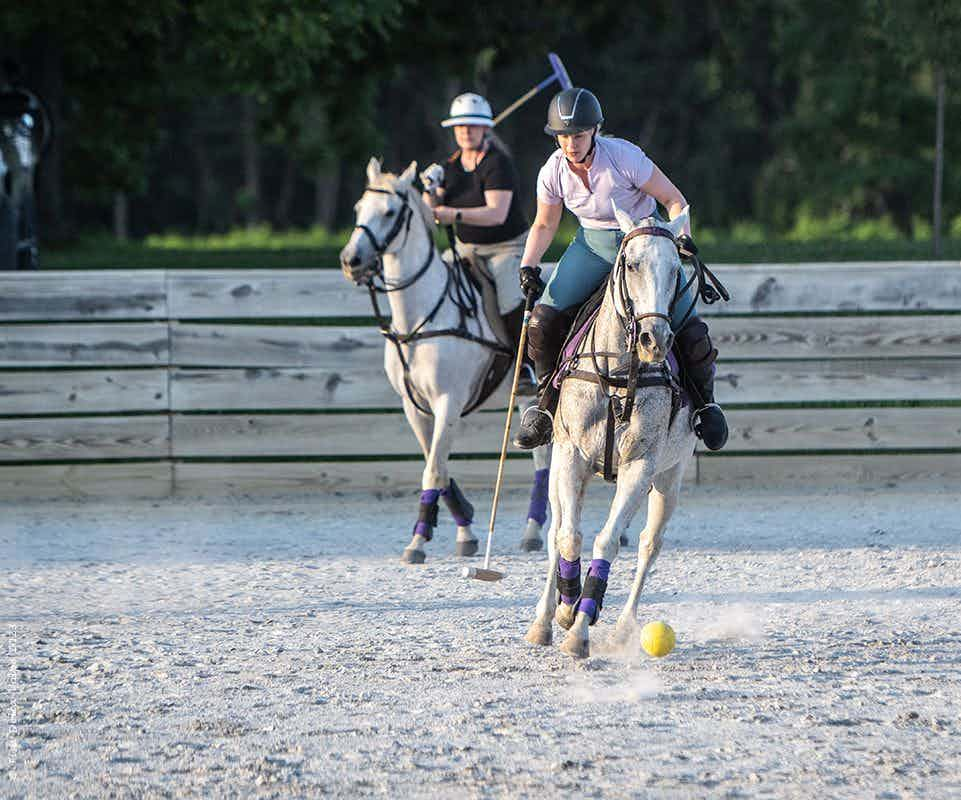Warming up to Warmbloods
Wrmblood horses have proliferated dramatically in the last several years in North America. Increases in importation and breeding numbers have led to this surge in popularity. These Hanoverians, Holsteiners, Trakehners, Oldenbergs, Selle Francais, Dutch Warmbloods, Swedish Warmbloods, Irish crossbreeds and others are being used with increasing regularity in the dressage and jumper rings where their size, power and agility is sought and admired.
Warmblood horses have proliferated dramatically in the last several years in North America. Increases in importation and breeding numbers have led to this surge in popularity. These Hanoverians, Holsteiners, Trakehners, Oldenbergs, Selle Francais, Dutch Warmbloods, Swedish Warmbloods, Irish crossbreeds and others are being used with increasing regularity in the dressage and jumper rings where their size, power and agility is sought and admired.

Warmbloods have been increasing in popularity over the last decade, and these breeds make up a large percentage of the horses used for dressage and jumping.
These horses have significantly more substance, heavier bones, more muscle and deeper barrels than other breeds and are known as much for their generally willing, tractable disposition as for their strength and power. Their size and presence has made these horses stand out in the competition ring, and with ever-increasing numbers, a Warmblood invasion is underway.
The Georgia Hunter Jumper equitation finals in 1998 had about an equal mix of Thoroughbred, Warmblood and other assorted breeds, but by 2005, every single finalist was a Warmblood. The American Warmblood registry has been in existence for 23 years and reports that within the last five years, the number of registered horses has more than doubled. There is only speculation as to the cause for this increased popularity, but these breeds are undoubtedly here to stay.
Equine veterinarians increasingly will be called to treat these burgeoning breeds, and it will be important to capitalize on these opportunities in practice.
It is important to note that there are some problems and conditions that are unique to these breeds that might warrant attention. The size, growth patterns and specific metabolic needs of these horses make them more likely to require nutritional management; their reproductive characteristics are somewhat unique, and there are a few diseases and conditions that seem to be more highly represented in Warmbloods.

This thermography scan shows increased heat associated with OCD lesions in the neck of this 4-year-old Dutch Warmblood. OCD lesions can occur in many different joints and will present as areas of pain and swelling and will limit the performance of the equine athlete.
To say that Warmbloods are "big horses that grow slowly" may seem obvious, but this simple statement speaks volumes about the nutritional idiosyncrasies of these breeds. The No. 1 goal of veterinarians advising Warmblood owners is to create a feeding program that ensures slow, steady growth.
These horses, as a group, are especially sensitive to developmental orthopedic disease (DOD) in its many forms. DOD is a group of several related metabolic disorders that affect the young horse from mid gestation through all early critical growth stages. A predisposing genetic component, environmental factors and deficiencies or imbalances of calcium (Ca), phosphorous (Ph), copper (Cu) and zinc (Zn) all contribute to these conditions, most of which center around a failure of cartilage maturation leading to soft, weak bones and joint surfaces. Epiphysitis (physitis), osteochondrosis dissecans (OCD), cervical vertebral malformation (Wobbler's Syndrome) and various flexural deformities are all manifestations of DOD.
The most common of these problems is OCD, which can be seen in a higher percentage of Warmbloods. In OCD cases, a failure of calcification leaves a plug of cartilage within developing subchondral bone. This area eventually results in a subchondral bone cyst, a cartilaginous flap or possible chips and fragments. As the affected horse develops and attempts to use this joint, the classic signs of effusion and pain result in lameness.
"It is unknown if the problem is increasing in frequency or being more frequently diagnosed due to superior radiographic equipment and technique," says Dr. Peter Huntington, an Australian equine researcher.
In a study of 83 German breeding farms, 226 of 629 foals between 5 and 10 months of age showed OCD lesions on radiographs. Many other similar studies have confirmed this genetic tendency, but research has also linked OCD to feeding practices. Overfeeding of carbohydrates is thought to alter the balance of hormones necessary for proper cartilage formation, and the slow-growth curve of Warmbloods, along with their large body frames, makes this overfeeding very risky. Therefore, low-glycine feeds are recommended for Warmbloods. These feeds provide energy through fat and fiber rather than through previously used starch and sugar. These low-glycine feeds use so-called super fibers, such as beet pulp and soy hulls, which can provide twice the energy of traditional fibers but in a safer form.
Many researchers suggest that growing Warmbloods might not even need concentrates if allowed access to good quality pasture and hay and supplemented with balanced amounts of Ca, Ph, Zn and Cu. This information has been available to owners and breeders for some time, but "unfortunately, some breeders have not embraced current research," Huntington observes.
Martin Adams, DVM, nutritionist with Southern States Equine Feeds, also agrees.
"Overfeeding and overweight young horses significantly contribute to developmental problems, and there are so many good commercial-feed options for breeders that can be utilized to reduce these conditions," he says.
Ensuring that broodmares do not become overweight, their diets must contain balanced energy-to-vitamin and mineral intake. Young Warmbloods, as well, must be kept slightly leaner and allowed to amass their natural weight slowly.
A 2-year-old Warmblood exhibits the long, rangy frame that is more comparable to a yearling Thoroughbred and traditionally, there are still major changes occurring to the bodies through age 5. Some bloodlines have well-documented growth spurts that occur as late as 7 to 8 years of age. This is verified by the European tradition of rarely putting Warmbloods into ridden work before they are age 4 to 5, though they will be ground driven extensively before that time.
Client education
Many clients will seek veterinary attention for conditions that include upward fixation of the patella, periodic hind-end weaknesses, inability of growing horses to correctly hold canter leads and even suspicion of EPM (equine protozoal myelitis).
While Warmbloods are certainly susceptible to all of these conditions, many times these problems are growth and development related, so the horses in question simply lack the balanced muscle and ligament strength at that particular stage of their development. The vast majority of such horses will "grow out of it" if allowed time to mature properly.
This process of slow maturation, along with lower carbohydrates and plenty of vitamins and minerals to build strong joints and bones, allows first for the development of a proper frame to carry the heavy muscle mass that will be put on in later years. Efforts to get these horses competing at higher levels earlier in their lives go against natural Warmblood development. Often the veterinarian's task in these situations is to educate the owner and ensure that the horse is given time to correct the problem itself. A healthy nutritional start and patience is often the best defense against later performance problems in these breeds.
EPSM
Another problem related to the peculiar metabolism of Warmbloods and draft-related breeds is equine polysaccharide storage myopathy or EPSM. On-going studies at the Neuromuscular Disease Lab at the New York State College of Veterinary Medicine at Cornell University have identified a metabolic defect in draft horses and related breeds, such as Warmbloods.
"Horses with EPSM seem not to be able to derive adequate muscle energy from carbohydrates," says Dr. Beth Valentine, co-author of "Draft Horses, an Owner's Manual."
The defect in metabolism, believed to be present in up to 50 percent of draft horses and a lesser percentage of Warmbloods and draft-related crosses, can cause a number of clinical problems. Affected horses may be stiff with mild to severe gait abnormalities. They might show difficulty cantering with an odd hind-limb motion. Some affected horses will be poorly muscled despite exercise or even show muscle wasting. Farriers often comment that these horses become difficult to shoe because they have problems holding up their hind feet. Tying up (exertional rhabdomyolysis) or signs consistent with muscle spasms are also seen. It is important to note that many of these signs, in their more subtle forms, are also seen in young, slowly developing but normal Warmbloods that lack adequate muscle and balance for their large frames. Differentiating between actual disease and developmental weakness can be a challenge for the practitioner.
Diagnosis of EPSM is by muscle biopsy, and because this disease can closely resemble other developmental issues, accurate diagnosis is to be encouraged. Treatment is a special diet high in fat. Valentine recommends a diet where 20 to 25 percent of the total digestible calories are derived from a fat source. Adding corn oil to the feed ration is one way to provide this diet, and there are many newer commercially prepared and balanced feeds that can be used for EPSM.
In a 2001 American Veterinary Medical Association study of 250 horses diagnosed with EPSM more than 88 percent of all horses showed significant improvement with a high-fat diet alone. Though the percentages of EPSM cases are higher for drafts than for Warmbloods, these breeds share some similar genetics, and this disease should be of concern for Warmblood owners and their veterinarians. Reducing the carbohydrate exposure for Warmbloods, already a good idea because of OCD concerns, is also of importance because of muscle function as well.
"Warmblood owners should avoid the temptation to feed all their horses a high-fat diet though because those Warmbloods not affected by EPSM will then be more at risk of becoming overweight with all of those potential complications," Adams cautions. The search for the exact problem with carbohydrate metabolism in these horses is progressing, and there is speculation that differences in Warmblood response to insulin may be involved.
Reproduction precautions
Reproduction in Warmbloods also can present the equine practitioner with some slightly unique challenges. Because much of the Warmblood breeding in this country is done with cooled or frozen semen, it is important for practitioners to have a good working knowledge of equine viral arteritis (EVA). EVA is a viral infection that affects horses and is particularly important because certain strains can cause abortions in susceptible mares, and a high percentage of stallions become carriers. Some breeds carry more EVA risk than others.
EVA "may occur in only 1 to 3 percent of the population in Arabians and Thoroughbreds, whereas it had reached 70 to 80 percent in Standardbreds," says Dr. Peter Timoney, a leading expert on EVA at the University of Kentucky Gluck Research Center.
There are a fairly significant number of Warmblood stallions that are EVA positive.
"Current estimates put the number at over 50 percent," Timoney says, and this can have economic implications for Warmblood breeding operations that may experience outbreaks of abortions and/or neonatal deaths. EVA abortions generally occur one to three weeks after exposure to the virus, and the mares may show no other signs of disease. The stage of pregnancy does not appear to influence the outcome as both early and late abortions can occur. Adding to the confusion, some severely affected mares do not abort. Most horses with EVA show signs of ataxia, fever, swelling of the limbs, anorexia, nasal discharge and skin rash around the head and neck. The majority of these horses tend to make uneventful recoveries and clearly, more remains to be learned about this disease.
EVA-positive semen serves as one means of spread of this disease, especially among Warmbloods, so veterinarians should be aware of the suggested methods for managing this problem. "Vaccination is the first line of defense against this disease," Timoney says. "All stallions should be vaccinated, and infected carrier stallions identified."
He also strongly recommends vaccinating young colts so that these horses do not get the chance to become infected and develop into carriers. Infected horses should be bred only to vaccinated mares. "Owners seem to have developed a 'mental hangover' concerning this disease," he adds, and many breeders cite problems with exporting vaccinated horses and the threat of lost sales or the inability to compete internationally as a major block to vaccination acceptance. But he refutes the claim.
"There is nothing in the importation/exportation regulations of the EU (European Union) that prohibits EVA vaccinated horses from international movement," he says. "Of the 64 horse-breeding countries in the world, the United States is the only one that has no import testing."
Testing, information about the status of imported horses and/or semen and vaccination would help control EVA in this country greatly, so it is very important that equine veterinarians understand this disease so that they can advise their Warmblood clients about the risks and options.
Other Warmblood breeding peculiarities also exist. Mary Alice Malone, respected Warmblood breeder and head of Iron Spring farm in Pennsylvania, observes that Warmbloods take more time to begin cycling and become fertile following the cessation of heavy training and showing than other breeds. These horses require time to develop normal cycles coming off an intense work regimen, and they might require a full year or more before they successfully become pregnant. She says she observes a higher percentage of abortions due to placentitis in Warmbloods as well.
Dr. Tom Stout, a reproductive specialist at the University of Utrecht (The Netherlands), has noted some breeding issues unique to Friesians. Though technically one of the draft breeds, the specific characteristics that Stout has identified are valuable to a discussion of Warmblood concern, too.
Writing in the "Select Breeders Services Breeding Manager's Forum", Dr. Stout observes, "Our experience is that Friesians do everything slower, tend to have a longer estrus and do develop much larger follicles. We don't get many Friesians that ovulate follicles much less than 45mm, and their follicles can develop to 60mm before ovulation without anything abnormal going on." Warmbloods do not show follicles quite that large, but they tend to produce larger follicles than most Arabians or Thoroughbreds.
Subtle differences between breeds are being categorized all the time as new research is produced. Warmbloods are unique breeds with some of their own specific problems and concerns. Equine practitioners should be aware of these differences and consider them when dealing with these increasingly popular horses.







